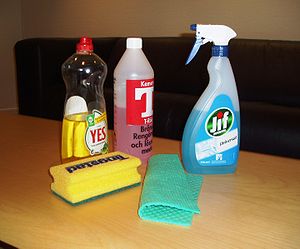
Packaging of detergents
Each detergent is a composition of many ingredients appropriately selected in the confectioning process. The basic substance is a surfactant.
The development of detergents can be traced, analyzing their changing composition. Various methods have been used to remove water hardness. Initially, sodium carbonate and sodium silicate were used. The removal of hardness consisted in the precipitation of calcium and magnesium ions. W 1907 in the year, Persil was introduced to the market, first "self-washing" agent. This product has been a branded product for many years, containing, except sodium carbonate and silicate, bleaching agent - sodium perborate.
The next stage in the development of detergents was the introduction of substances with the properties of complexing calcium and magnesium ions. Complexing agents, i.e.. binding calcium and magnesium ions into permanent complex compounds, are polyphosphates. A proven and used agent for decades was sodium tripolyphosphate. In addition to binding calcium and magnesium ions, phosphates (polifosforany) they also bind heavy metal ions, have dirt dispersing properties (dispersing dirt in the washing bath) and preventing re-deposition of dirt on the fabric. They also protect the fabric against the mineralization of fibers, thus the precipitation of inorganic salts thereon. At the same time, they increase the detergency of surfactants. Therefore, they play a particularly important role in the composition of a washing agent. Compounds that fulfill these tasks are called builders, which are now regarded as the most important component of laundry detergent compositions. The reduction of active fillers in washing agents or their inappropriate selection causes a reduction in washing performance, stiffening and graying of the linen and deposition of sediments on the elements of washing machines. The quality and quantity of the builder thus affects the effectiveness of the surfactants, as well as enzymes and whitening effect.
The further development of washing agents was related to the work on introducing and improving the effectiveness of bleaching agents, enzymes and other additives. Ecological considerations made it necessary to reduce the amount of phosphates used. The use of phosphates has been criticized for the increasing eutrophication of stagnant and slowly flowing surface waters. Eutrophication is the growth of nutrients in stagnant water bodies, leading to the excessive development of fauna and flora, and consequently to shallowing of the reservoirs and then transition to peat bogs. IN USA, In Western Europe and Japan, laws or voluntary agreements have been made to significantly reduce or prohibit the use of phosphates. The turning point was the discovery of the so-called. zeolite A (sodium aluminum silicate), which started the production of phosphate-free, so ecological washing powders.
The chemical composition of the detergent must take into account the type of fabric, for which the measure is intended.
In the case of cellulose fibers (Cotton, len, cellulosic man-made fibers) alkaline washing bath is indicated, this environment has a positive effect on the quality of these fibers, however, in an acidic environment, these fibers deteriorate.
The reverse is true for protein fibers (wool, natural silks, proteinaceous artificial fibers), which in an alkaline environment, especially at elevated temperatures, decompose, on the other hand, they are resistant to weak acids, under the condition, that they do not work at elevated temperatures.
It follows from here, that detergents for washing cellulose fibers should form alkaline washing baths, these may be agents that function effectively even at higher temperatures. Protein fiber washing agents should be effective at low temperatures and create neutral or slightly acid washing baths.. The intended use of the detergent is therefore related to the selection of the surfactant in terms of its reaction and temperature, at which it achieves maximum washing capacity.
When selecting a detergent composition, economic aspects should also be taken into account. Measures are increasingly being preferred, that function effectively at low temperatures, which saves electricity during washing.
The main features of modern laundry detergents are: high efficiency, care and protection of washed fabrics and compliance of the entire composition with the natural environment. The main components of modern agents are surfactants, active filler combinations and fabric bleaching systems. The combinations of these main ingredients are supported in their washing activity by small amounts of various additives, such as: enzymes, optical brighteners, stabilizers and others.
Packaging of detergents, used as washing agents, it is about creating a composition that is harmless to humans, non-irritating to the skin and a mild surfactant with oily substances, moisturizing and caring for the skin.